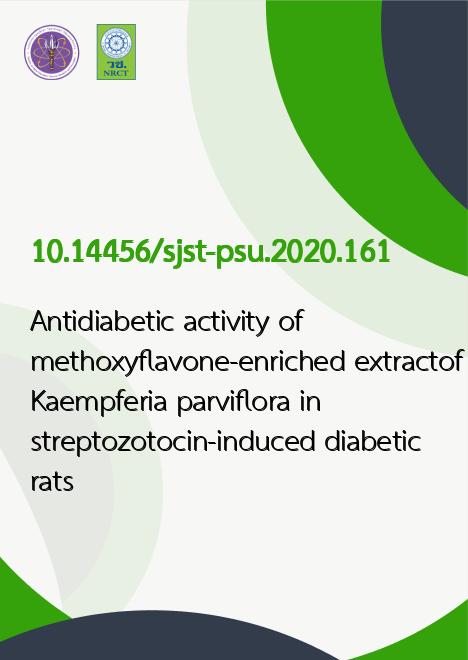
|
Antidiabetic activity of methoxyflavone-enriched extractof Kaempferia parviflora in streptozotocin-induced diabetic rats |
|---|---|
| รหัสดีโอไอ | |
| Creator | 1. Bungorn Sripanidkulchai 2. Somsuda Somintara 3. Choowadee Pariwatthanakun 4. Kittisak Sripanidkulchai 5. Vijittra Leardkamolkarn |
| Title | Antidiabetic activity of methoxyflavone-enriched extractof Kaempferia parviflora in streptozotocin-induced diabetic rats |
| Publisher | Research and Development Office, Prince of Songkla University |
| Publication Year | 2563 |
| Journal Title | Songklanakarin Journal of Science and Technology |
| Journal Vol. | 42 |
| Journal No. | 6 |
| Page no. | 1239-1247 |
| Keyword | Kaempferia parviflora, insulin, flavonoids, glibenclamide |
| URL Website | https://rdo.psu.ac.th/sjstweb/index.php |
| ISSN | 0125-3395 |
| Abstract | Kaempferia parviflora has been traditionally used in folk medicine. This study investigates the hypoglycemic effects ofthe methoxyflavone-enriched ethanol extract of K. parviflora (MKE) in streptozotocin-induced diabetic rats. Compared to thecontrol and vehicle groups, MKE at 150 and 300 mg/kg significantly decreased blood glucose, comparably to glibenclamide. Thedamage to the Islets of Langerhans was found to be ameliorated in the MKE-treated groups, with twice the increase in the cellcount of the Islets. Immunohistological staining showed the loss of insulin as characterized by diffuse staining of the cells in thepancreas of the streptozotocin-induced diabetic rats. MKE-treated groups showed an increase in insulin density in the pancreas ofthe diabetic rats, similar to the glibenclamide-treated group. MKE at both doses and glibenclamide decreased the hepatic MDAcontent, but statistical significance was found only for the glibenclamide-treated group. The degeneration of renal tubules andcell necrosis in the kidneys decreased in the MKE-treated groups. |
